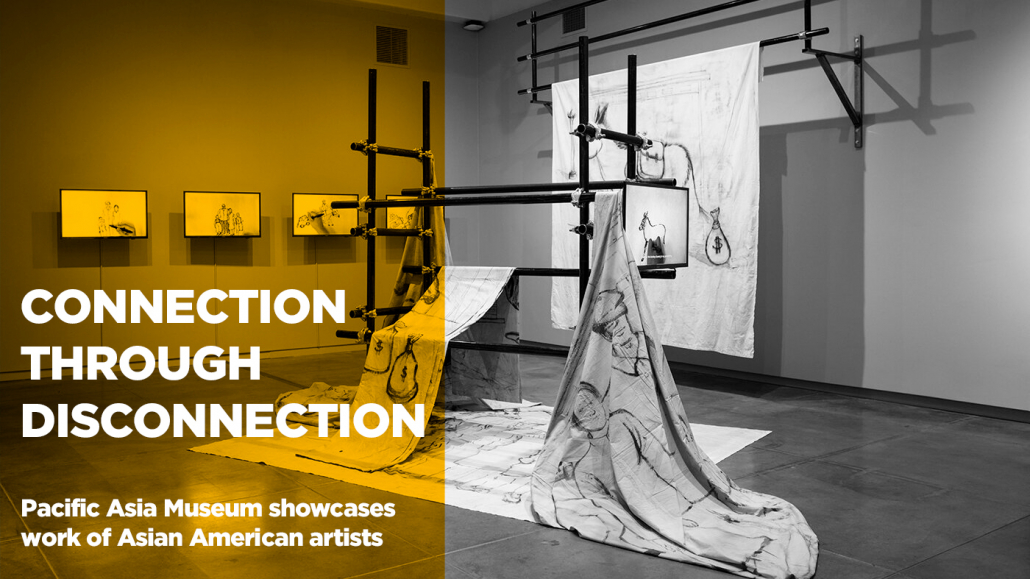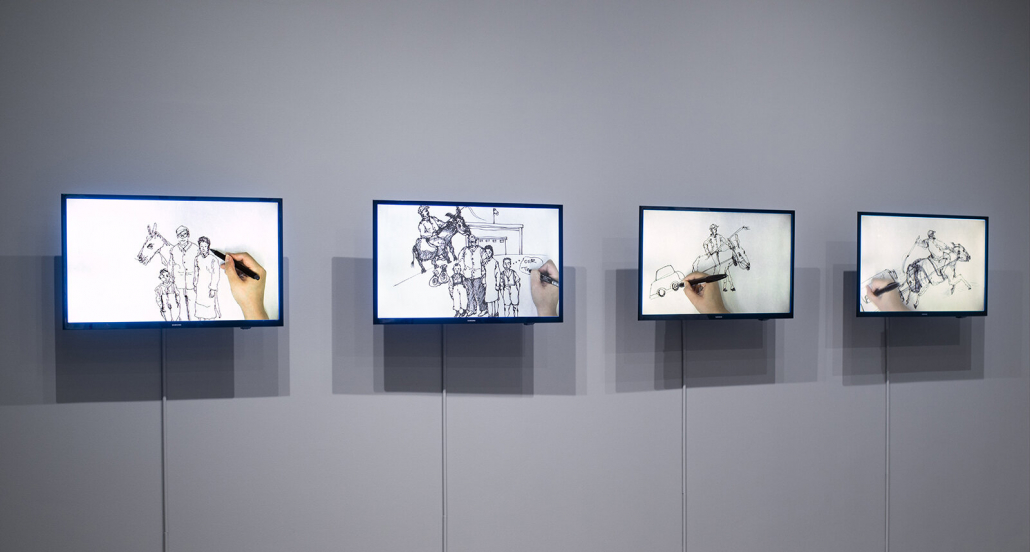Connection through disconnection: Pacific Asia Museum showcases work of Asian American artists

When USC Pacific Asia Museum curator Rebecca Hall began planning the “We Are Here: Contemporary Art and Asian Voices in Los Angeles” exhibition in 2019, she never expected the show to close within one week of its March 2020 opening. The show finally got its long overdue time in the limelight when the exhibition reopened for one week beginning May 29. However, showcasing the voices of Asian American female artists took on a completely new meaning a year later.
After falling in love with a book about traditional Thai textiles, Hall began studying and teaching Southeast Asian art history, which culminated in her position as a museum curator at the USC Pacific Asia Museum. During her past three years at the Pacific Asia Museum, Hall noticed a disconnect between how Asian Americans felt and how they were being represented in museums.
“I’ve always felt like there’s always a disconnect between lived experiences and museums, but I also was hearing from people that they felt like the Pacific Asia Museum doesn’t represent their communities and [that] they don’t feel connections to what they were seeing,” Hall said. “I think [it’s] because, when museums and collectors collect Asian art, [we] have this ideal perspective on what Asia is … and it doesn’t necessarily reflect the larger truth of the history.”
With this disconnect in mind, Hall sought out seven Asian American female artists in Los Angeles to create an exhibition that extends viewers’ understanding of the expansive and complicated Asia Pacific heritage. One artist featured in Hall’s exhibition is Mei Xian Qiu, an ethnic Chinese minority individual who was born in Java, Indonesia and immigrated to the United States as a result of the Communist genocide. With a Chinese name, an Indonesian name and a Catholic name, Qiu takes inspiration from the restless, diasporic experience of Asian Americans. At the exhibition, Qiu displayed “Let a Thousand Flowers Bloom,” a collection of pieces that portrayed the interaction between Western archetypes on what the Chinese identity looked like and self-constructed perception of what the Chinese identity was, as someone who didn’t quite understand Chinese culture despite being ethnically Chinese herself. The pieces have a common theme of depicting Pan-Asian models dressed in stereotypical Chinese clothing from the Mao era, against American landmarks such as the White House and the Grand Canyon, or Western themes such as The Temptation of Eve.
“When you are a person from a certain diaspora … as opposed to someone who is in China from China, your identity is much more clear,” Qiu said. “But when you identify yourself as American or Indonesian or Chinese-American-Indonesian, there is a kind of a disconnect between … how people perceive China — China as a country and who we are as Americans.”
“Let a Thousand Flowers Bloom” featured photographs of a dystopian fictional mafia invasion carried out by Chinese and Pan-Asian American actors, but purposely used tropes that Westerners would perceive as stereotypically Chinese. Qiu said she conducted a lot of research prior to this project because the subject was so complicated, as well as “acutely painful and acutely shared.”
“I’m really interested in this idea of creating identities and also [in], not only the type of propaganda that is put forth in order to make people believe in something, but [also] the type of stories that we create to make sense of our own lives in a way we have to,” Qiu said. “I think a lot of people have to create a reality that makes sense to them these days, and that often has elements of fiction and nonfiction in it.”
To Qiu, there’s always an element of the artist’s humanity that goes into each work, and even though what viewers take away may not always be what the artist intends, Qiu’s goal is for her art to ask questions the viewer can answer.
“I’ve done a lot of work that dealt with what Chinese meant coming from a culture where we were identified as Chinese but [were] never really part of the main Chinese culture,” Qiu said.
As her time went on as an artist, Qiu thought about shifting her gaze to the Indonesian experience because it is a story that is underrepresented for Western viewers.
Sharing the exhibition room with Qiu is Sichong Xie, an interdisciplinary artist whose art addresses Chinese identity, politics and cross-culturalism. Xie displayed a multimedia video and scaffolding installation titled “Do Donkeys Know Politics?” that tells the story of her grandfather, who was sent to a labor camp in China for drawing a political cartoon in the 1950s. Xie’s multimedia video consisted of five clips that show the multiple iterations of cartoon drafts as she received critique from her grandmother while trying to redraw the cartoon based on her grandmother’s memories.
The scaffolding installation is representative of her grandfather’s career as an architect and shows the temporary, “invisible labor” of construction workers that is lost once the architecture is completed. During the pandemic, Xie began working on her second scaffolding project that features bamboo scaffolding that is popular in her hometown of Xi’an, China, as well as embroidery of the floor plans her grandfather designed for residential homes in the 1950s that were never built. Through embroidery, which is labor intensive yet meditating, Xie said she hopes to make the “invisible labor” more visible to viewers. Due to the coronavirus pandemic, Xie was unable to visit her family in Xi’an, but the distance motivated her to delve deeper into her grandfather’s history and channel her anxieties into art.
Following the abrupt closing of the show in March, the USC Pacific Asia Museum was quick to transition the exhibit into a virtual format. Because Xie’s art is three-dimensional and performative, transitioning her projects to be consumed virtually caused a lot of its depth to be lost.
“I feel like it’s a totally different experience seeing performance in person rather than seeing the documentation of it,” Xie said. ”You don’t have a scale in mind if you view the sculpture from the computer screen.”
Qiu also believes that viewing art virtually makes it difficult to fully engage in it.
“A lot of my pieces have texture … and have been changed through non-mechanical means … where you have to see it because there’s a dimensionality to it. I think it’s easy to gloss over work when you see it virtually, but it’s easier to engage in work when you see it in person,” Qiu said. “Maybe it’s not so confrontational, but it forces engagement, when you’re there [in that environment] … I went there in person after not seeing it for a long time, and it had a big effect on me.”
Xie said that even though “Do Donkeys Know Politics?” was completed in February 2020, since she hadn’t seen the installation in a year, it felt old and new at the same time when the show reopened a few weeks ago. For Hall and all the artists who participated, seeing the exhibition with the lens of people who recently experienced an upsurge in Asian American hate was very emotional.

“I worked on the exhibition for a year before it opened, and then during COVID, while we were closed, our entire understanding — and I mean larger — American understanding of AAPI experiences [changed]. All of a sudden, the exhibition took on new meaning,” Hall said. “Selfishly, I really want everybody to love the diversity of our Asian communities as much as I do and to understand them.”
Creating a better understanding of the Pan-Asian experience may be popular in the media now because of Asian American hate, but it has always been crucial to narrowing the disconnect that Asian diasporic individuals feel in American society. Hall had been working on the exhibition for over a year before its unexpected closing, and said that it was “nice to have something that helped expand our perspectives on the subject” since there was “no way we could have ever known what was going to happen.”
“I almost cried when I heard about the show, and I was really honored to be part of it because I just feel like this was a voice that we need to have, much like Asian American male voice. In Los Angeles, has there been a show like that before? I just felt that it was so important,” Qiu said.
Xie also said that many experiences are shared across different Pan-Asian heritages, which is why Hall’s position as a curator that covers such a broad geographical area allows for her to create community instead of delving into the nuances of one particular region.
“It’s really interesting because every artist in this show — their story is so honest. And it’s a family, personal experience,” Xie said. “All those issues and concerns they brought up in their work [are] important to pay attention to, especially if you don’t really know different stories from the Asian community in Los Angeles.”
The disconnect between Pan-Asian experiences and Pan-Asian representation in museums, media and daily life made it necessary for Hall to use her position as a museum curator to deepen viewers’ understanding, especially during this period of heightened racial tension.
“I think what also drove me crazy was that anytime you would see something in print about L.A.’s Asian communities, it was often about food … I mean, who doesn’t love that? But on the other hand, there’s so much more complexity to these communities,” Hall said. “I just wanted that to come across. If somebody comes through the exhibition with no knowledge and they have an appreciation for the individuality of the artists … and understanding of the AAPI experience in a little bit more in depth, I would be very happy about that.”
Though the in-person show of the exhibition has already closed, the virtual exhibition can still be accessed on the Pacific Asia Museum’s website, and the museum continues to do its part in educating viewers about the Pan-Asian experience.

